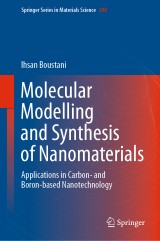Details

Molecular Modelling and Synthesis of Nanomaterials
Applications in Carbon- and Boron-based NanotechnologySpringer Series in Materials Science, Band 290
|
149,79 € |
|
| Verlag: | Springer |
| Format: | |
| Veröffentl.: | 14.07.2020 |
| ISBN/EAN: | 9783030327262 |
| Sprache: | englisch |
Dieses eBook enthält ein Wasserzeichen.
Beschreibungen
This book presents nanomaterials as predicted by computational modelling and numerical simulation tools, and confirmed by modern experimental techniques. It begins by summarizing basic theoretical methods, then giving both a theoretical and experimental treatment of how alkali metal clusters develop into nanostructures, as influenced by the cluster's "magic number" of atoms. The book continues with a discussion of atomic clusters and nanostructures, focusing primarily on boron and carbon, exploring, in detail, the one-, two-, and three-dimensional structures of boron and carbon, and describing their myriad potential applications in nanotechnology, from nanocoating and nanosensing to nanobatteries with high borophene capacity. The broad discussion of computational modelling as well as the specific applications to boron and carbon, make this book an essential reference resource for materials scientists in this field of research.
<div>Foreword.- Preface.- Part I Molecular Modelling & Magic Clusters.- 1 Molecular Modelling.- 2 Magic Numbers & Clusters.- 3 Alkali Metal Clusters.- Part II The p-Block Non-Metal Clusters.- 4 The Element Boron.- 5 The Element Carbon.- Part III Modelling of Nanostructures.- 6 Two-Dimensional Sheets.- 7 One-Dimensional Nanotubes.- 8 Three-Dimensional Fullerenes.- Part IV Potential Application in Nanotechnology.- 9 Nano Battery.- 10 Nanosensors and Fullerenes.- 11 Semi-Emperical Methods.- Index.</div>
This book presents nanomaterials as predicted by computational modelling and numerical simulation tools, and confirmed by modern experimental techniques. It begins by summarizing basic theoretical methods, then giving both a theoretical and experimental treatment of how alkali metal clusters develop into nanostructures, as influenced by the cluster's "magic number" of atoms. The book continues with a discussion of atomic clusters and nanostructures, focusing primarily on boron and carbon, exploring, in detail, the one-, two-, and three-dimensional structures of boron and carbon, and describing their myriad potential applications in nanotechnology, from nanocoating and nanosensing to nanobatteries with high borophene capacity. The broad discussion of computational modelling as well as the specific applications to boron and carbon, make this book an essential reference resource for materials scientists in this field of research.
Explores the interplay between theoretical prediction and experimental discovery Rich in useful figures and references Discusses the historical evolution of the role of theory in materials science
Diese Produkte könnten Sie auch interessieren:

Neutron Applications in Earth, Energy and Environmental Sciences

von: Liyuan Liang, Romano Rinaldi, Helmut Schober

149,79 €

Nanobioelectronics - for Electronics, Biology, and Medicine

von: Andreas Offenhäusser, Ross Rinaldi

96,29 €














